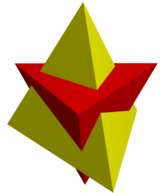It has been suggested that this article be merged into Stellated octahedron . (Discuss) Proposed since March 2025. |

In geometry, a compound of two tetrahedra is a polyhedral compound constructed by two overlapping tetrahedra, usually implied as regular tetrahedra.














